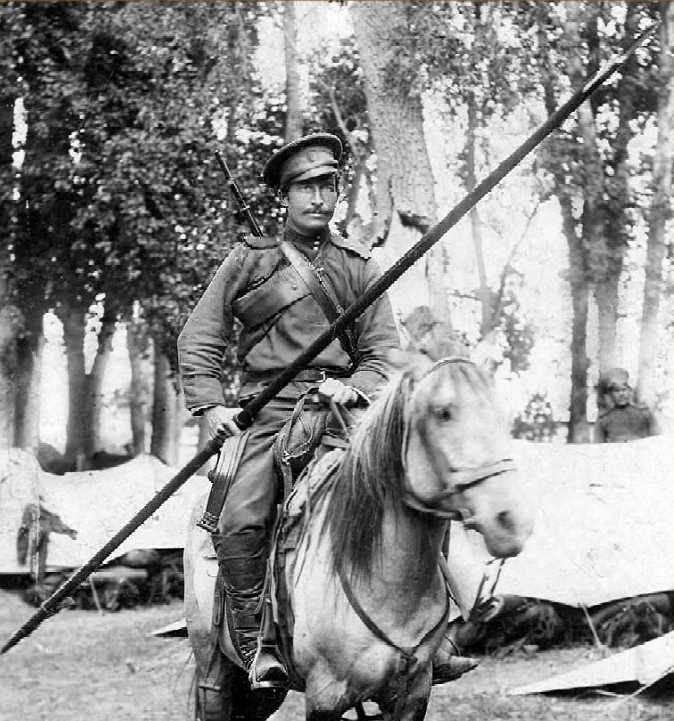
Steppe Dress

Most Cossack Hosts wore an outfit only differing in minor details from normal Russian cavalry, especially in the field version. This should be a Cossack because he is carrying his rifle so that it comes out on his right hand side, whereas regular cavalry carried them the other way, and he appears not to have spurs.
Basics
Traditionally Cossack trousers were baggy and blue, with very wide stripes of host colour. In practice khaki trousers were worn too, either with or without the stripe, and many were standard cut.
The boots were worn without spurs. Instead a nagaika whip was used.
Headgear
Most men seem to have worn the standard furazhka cap in decent weather.
They also wore fur papakha, especially in winter. The further east the Host, the shaggier this becomes. The Don Cossacks favouring the small kubanka, whereas the Siberians tended to much larger and furrier items.
It was normal for Cossacks to wear their hats at an angle, sometimes alarmingly so.
Bashlyks were also worn in bad weather, but were not the brightly coloured things of the Caucasian tribes and hosts. Instead most were the natural colours of camel-hair cloth.
Weapons
All steppe Cossacks used lances. Imperial practice, and the Civil War units almost certainly did the same, was for a battle formation with the front rank lance armed and the back rank sabre armed.
The Cossack lance was of metal, and painted black. According to the Handbook it was shorter than the regular cavalry lance at 2.75 metres, although it says that Cossacks were moving over to the longer one (3.25m). Some English bamboo lances were used by AFSR troops. Pennons were not flown in wartime.
Officially men were armed thus:
- Cossack cavalry carried sabres and carbines without bayonet (slung on their backs, never saddle).
- Cavalry machine-gunners carried pistols and swords.
- Infantry machine-gunners carried a carbine and dagger (rather than bayonet).
- Artillery carried pistol and dagger, except scouts and transport who had a carbine and dagger.
- Officers, sergeant-majors and trumpeters, carried a pistol and sword, regardless of branch of service.
In practice during the Civil War men tended to carry multiple weapons.
Markings
Shoulderboard and sleeeve markings were standard Russian pattern.
Machine-gunners wore wide crimson cuff lace on the blouse and greatcoat. This includes the machine-gun sections of the cavalry, so likely was extended to tachanka units as well.
Infantry scouts wore wide green braid cuff lace on the blouse and greatcoat. Cavalry scouts had a vertical dark orange stripe on the shoulderboard instead.
Pioneers in infantry or cavalry units wore a crossed tools badge high on their left sleeve. Signallers, telephonists etc had different badges, depending on their speciality.
Dedicated engineer units carried their specialist badge on their shoulderboards, not sleeve.